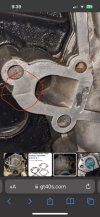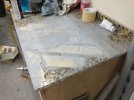David Garton
Supporter
If you look at what failed it appears to have filled the back of the plate from the void in the timing cover surface. You are so close to removing and replacing the timing cover with just the removal of the balancer. It's a lot of work to be in the same boat down the road. Plus you would be installing new timing cover to block gasket with the new cover. Just my thoughts. Something to think about you are more than capable to take the next step. Doing great either way..


